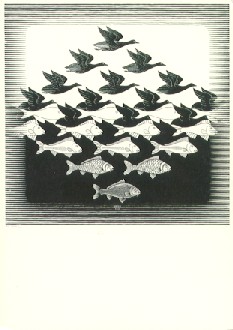

|
"In the horizontal center strip there are birds and fish equivalent to
eachother. We associate flying with sky, and so for each of the black birds
thesky in which it is flying is formed by the four white fish which
encircleit. Similarly swimming makes us think of water, and therefore the
fourblack birds that surround a fish become the water in which it swims."
M.C.E.
This print has been used is physics, geology, chemistry, and in psychology for
the study of visual perception. In the picture a number of visual elements
unite into a simple visual representation, but separately each forms a point
of departure for the elucidation of a theory in one of these disciplines. The
basis of this print is a regular division of the plane consisting of birds and
fish. We see a horizontal series of these elements - fitting into each other
like the pieces of a jigsaw puzzle - in the middle, transitional portion of
the print. In this central layer the pictorial elements are equal: birds and
fish are alternately foreground or background, depending on whether the
eye concentrates on light or dark elements. The birds take on an
increasing three-dimensionality in the upward direction, and the fish, in
the downward direction. But as the fish progress downward they gradually lose
their shapes to become a uniform background of sky and water, respectively.
We can think of a number of paired concepts applying to this picture:
light-dark, top-bottom, flat-rounded, figure-background, interlocking
pictorial elements-independent pictorial elements, geometric
structure-realistic form; and, with respect to the subject of the print,
birds-fish, sky-water, immobility-movement. Any scientist who uses a print
to illustrate a theory selects one or more elements from the print that
are analogous to components of the theory, and in this way the print becomes a
model for the theory.C.H.A. BROOS